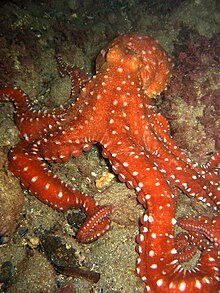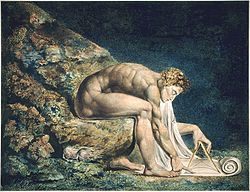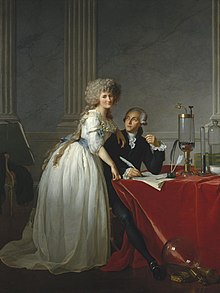Portal:History of science
The History of Science Portal
The history of science covers the development of science from ancient times to the present. It encompasses all three major branches of science: natural, social, and formal. Protoscience, early sciences, and natural philosophies such as alchemy and astrology during the Bronze Age, Iron Age, classical antiquity, and the Middle Ages declined during the early modern period after the establishment of formal disciplines of science in the Age of Enlightenment.
Science's earliest roots can be traced to Ancient Egypt and Mesopotamia around 3000 to 1200 BCE. These civilizations' contributions to mathematics, astronomy, and medicine influenced later Greek natural philosophy of classical antiquity, wherein formal attempts were made to provide explanations of events in the physical world based on natural causes. After the fall of the Western Roman Empire, knowledge of Greek conceptions of the world deteriorated in Latin-speaking Western Europe during the early centuries (400 to 1000 CE) of the Middle Ages, but continued to thrive in the Greek-speaking Byzantine Empire. Aided by translations of Greek texts, the Hellenistic worldview was preserved and absorbed into the Arabic-speaking Muslim world during the Islamic Golden Age. The recovery and assimilation of Greek works and Islamic inquiries into Western Europe from the 10th to 13th century revived the learning of natural philosophy in the West. Traditions of early science were also developed in ancient India and separately in ancient China, the Chinese model having influenced Vietnam, Korea and Japan before Western exploration. Among the Pre-Columbian peoples of Mesoamerica, the Zapotec civilization established their first known traditions of astronomy and mathematics for producing calendars, followed by other civilizations such as the Maya.
Natural philosophy was transformed during the Scientific Revolution in 16th- to 17th-century Europe, as new ideas and discoveries departed from previous Greek conceptions and traditions. The New Science that emerged was more mechanistic in its worldview, more integrated with mathematics, and more reliable and open as its knowledge was based on a newly defined scientific method. More "revolutions" in subsequent centuries soon followed. The chemical revolution of the 18th century, for instance, introduced new quantitative methods and measurements for chemistry. In the 19th century, new perspectives regarding the conservation of energy, age of Earth, and evolution came into focus. And in the 20th century, new discoveries in genetics and physics laid the foundations for new sub disciplines such as molecular biology and particle physics. Moreover, industrial and military concerns as well as the increasing complexity of new research endeavors ushered in the era of "big science," particularly after World War II. (Full article...)
Selected article -

Aristotle's biology is the theory of biology, grounded in systematic observation and collection of data, mainly zoological, embodied in Aristotle's books on the science. Many of his observations were made during his stay on the island of Lesbos, including especially his descriptions of the marine biology of the Pyrrha lagoon, now the Gulf of Kalloni. His theory is based on his concept of form, which derives from but is markedly unlike Plato's theory of Forms.
The theory describes five major biological processes, namely metabolism, temperature regulation, information processing, embryogenesis, and inheritance. Each was defined in some detail, in some cases sufficient to enable modern biologists to create mathematical models of the mechanisms described. Aristotle's method, too, resembled the style of science used by modern biologists when exploring a new area, with systematic data collection, discovery of patterns, and inference of possible causal explanations from these. He did not perform experiments in the modern sense, but made observations of living animals and carried out dissections. He names some 500 species of bird, mammal, and fish; and he distinguishes dozens of insects and other invertebrates. He describes the internal anatomy of over a hundred animals, and dissected around 35 of these. (Full article...)Selected image

Poet and artist William Blake criticized Newton and like-minded philosophers such as Locke and Bacon for relying solely on reason.
Blake's 1795 print Newton is a demonstration of his opposition to the "single-vision" of scientific materialism: the great philosopher-scientist is shown utterly isolated in the depths of the ocean, his eyes (only one of which is visible) fixed on the compasses with which he draws on a scroll. His concentration is so fierce that he seems almost to become part of the rocks upon which he sits.
Did you know
... that the Merton Thesis—an argument connecting Protestant pietism with the rise of experimental science—dates back to Robert K. Merton's 1938 doctoral dissertation, which launched the historical sociology of science?
...that a number of scientific disciplines, such as computer science and seismology, emerged because of military funding?
...that the principle of conservation of energy was formulated independently by at least 12 individuals between 1830 and 1850?
Selected Biography -
Antoine-Laurent de Lavoisier (/ləˈvwɑːzieɪ/ lə-VWAH-zee-ay; French: [ɑ̃twan lɔʁɑ̃ də lavwazje]; 26 August 1743 – 8 May 1794), also Antoine Lavoisier after the French Revolution, was a French nobleman and chemist who was central to the 18th-century chemical revolution and who had a large influence on both the history of chemistry and the history of biology.
It is generally accepted that Lavoisier's great accomplishments in chemistry stem largely from his changing the science from a qualitative to a quantitative one. Lavoisier is most noted for his discovery of the role oxygen plays in combustion. He named oxygen (1778), recognizing it as an element, and also recognized hydrogen as an element (1783), opposing the phlogiston theory. Lavoisier helped construct the metric system, wrote the first extensive list of elements, and helped to reform chemical nomenclature. He predicted the existence of silicon (1787) and discovered that, although matter may change its form or shape, its mass always remains the same. His wife and laboratory assistant, Marie-Anne Paulze Lavoisier, became a renowned chemist in her own right. (Full article...)Selected anniversaries
- 1691 - Death of Adrien Auzout, French astronomer (b. 1622)
- 1707 - Birth of Carl Linnaeus, Swedish botanist (d. 1778)
- 1734 - Birth of Franz Mesmer, Austrian physician/hypnotist (d.1815)
- 1857 - Death of Augustin-Louis Cauchy, French mathematician {b. 1789)
- 1884 - Birth of Corrado Gini, Italian sociologist (d. 1965)
- 1887 - Birth of Thoralf Skolem, Norwegian mathematician (d. 1963)
- 1893 - Birth of Ulysses S. Grant IV, American geologist and paleontologist (d. 1977)
- 1895 - Death of Franz Ernst Neumann, German mineralogist and physicist (b. 1798)
- 1908 - Birth of John Bardeen, American physicist and Nobel Prize laureate (d. 1991)
- 1917 - Birth of Edward Norton Lorenz, American mathematician and meteorologist
- 1925 - Birth of Joshua Lederberg, American molecular biologist and Nobel Prize laureate
- 1958 - Explorer 1, the first US Earth satellite, ceases transmission.
- 2002 - The "55 parties" clause of the Kyoto Protocol is reached after its ratification by Iceland.
Related portals
Topics
General images
Subcategories
Things you can do
Help out by participating in the History of Science Wikiproject (which also coordinates the histories of medicine, technology and philosophy of science) or join the discussion.
Associated Wikimedia
The following Wikimedia Foundation sister projects provide more on this subject:
-
Commons
Free media repository -
Wikibooks
Free textbooks and manuals -
Wikidata
Free knowledge base -
Wikinews
Free-content news -
Wikiquote
Collection of quotations -
Wikisource
Free-content library -
Wikiversity
Free learning tools -
Wiktionary
Dictionary and thesaurus









































































